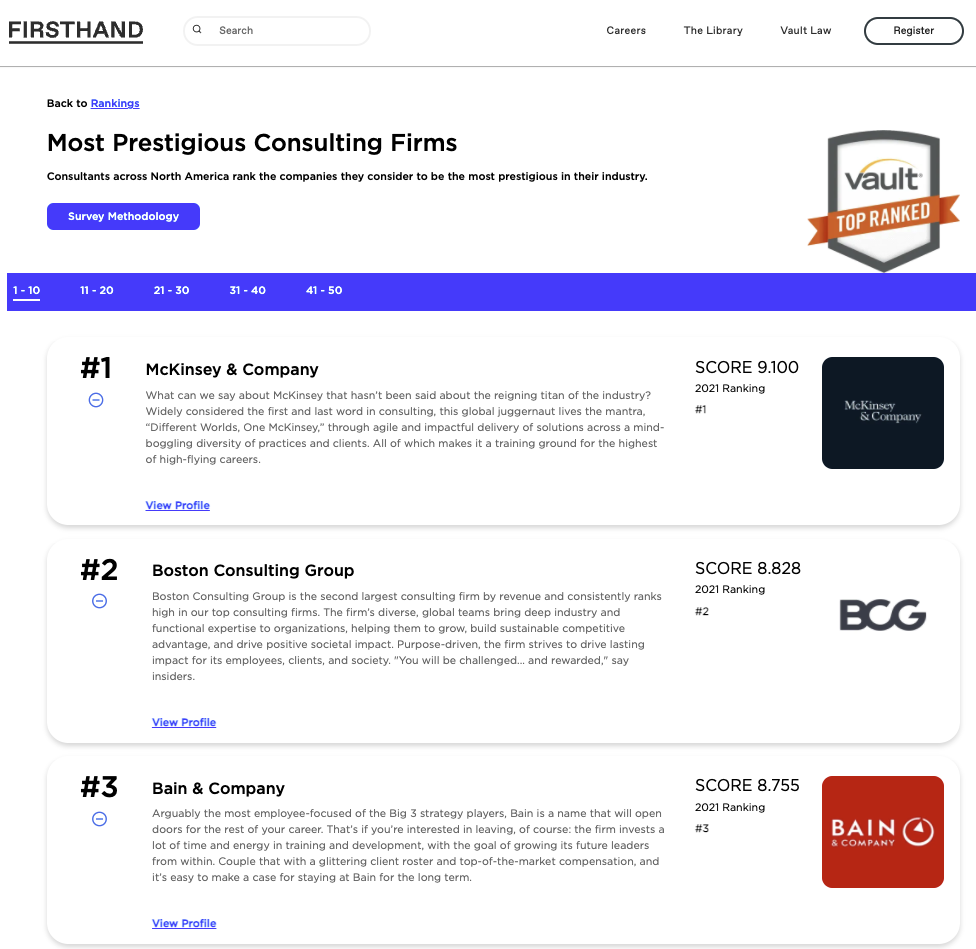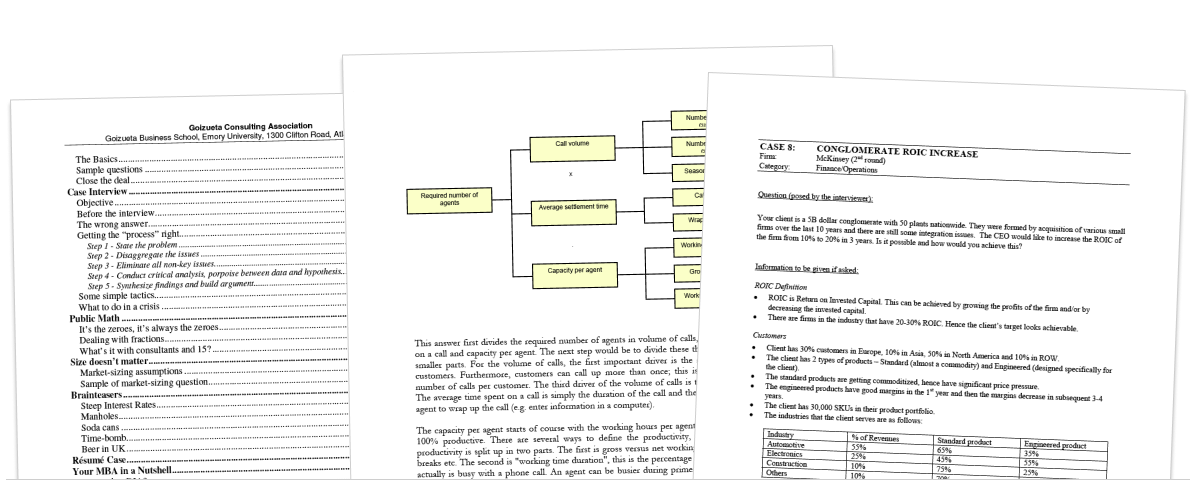So you’re a fresh graduate or experienced professional who is looking to get into consulting.
But consulting is a competitive industry and you don’t know how to break in.
Don’t fear. In this article, we give you clear, actionable steps to get your consulting dream job.
Why should you become a consultant?
Consultants solve complex business problems for their clients. Their core skillset is to break down ambiguous problems, identify root causes, and provide clear recommendations on how to solve those problems.
It’s also a great way to start and/or accelerate your career:
- You will learn and progress quickly: As a consultant, you’ll work on project teams that work directly with senior leaders at your client organization and you’ll change projects every 3-4 months on average.
- You will build a strong network: Long days and challenging projects mean that you’ll build close relationships with your team members, who are all intelligent, motivated, and hard-working.
- You will get a broad range of experiences: In many consulting firms, you’ll work as a generalist and get exposure to a wide variety of industries and functional areas.
- You will get great exit opportunities: The consulting skillset and experience is highly regarded by employers, so you’ll have the opportunity to exit into highly desirable roles and senior positions.
Which consulting firms should you target?
Consulting firms can be categorized into four main groups:
- MBB: McKinsey, Bain, and BCG are the three most distinguished strategy consulting firms. They are “pure-play” firms, which means they started as strategy houses, and only later branched into other forms of consulting. They only accept the very top candidates, so it’s a strong signal of your talent and potential.
- Mid-Tier: These firms also provide strategy consulting work to large corporates. Although they cannot compete head-to-head with MBB firms for most work, they generally have a few niches where they are strong. For example, L.E.K Consulting is a mid-tier firm that is particularly strong in healthcare and pharma.
- Big 4: EY, PwC, Deloitte and KPMG started off as accounting firms and then branched into consulting. Their clientele is often middle-management level instead of senior executives, and they typically work on less impactful problems (e.g. implementation, cost-cutting, PMO, etc).
- Boutique: These firms are smaller consulting firms that have an industry focus (e.g. healthcare), functional specialization (e.g. operational improvement), or limited geographic scope (e.g. UK only).
As you can imagine, most candidates want to work for an MBB firm.
However, they are considered to have one of the most competitive recruitment processes in the world. MBB firms regularly have acceptance rates below 1.5%.
Fortunately, you can apply for multiple firms at the same time. So, much like applying to university, you can have “reach” consulting firms, “target” consulting firms, and “safety” consulting firms.

How to get into consulting (step-by-step)
Consulting firms look for exceptional and well-rounded candidates.
As a candidate, you need to start with the skills, experience, and qualifications that consulting firms want. And then you need to ace your interviews during the recruitment process.
Step 1. Build the right skills and experience
Consulting firms will only consider interviewing candidates with the right skills and experience, so it’s important that you can demonstrate these in your resume and cover letter.
Top consulting firms expect their undergraduate and graduate hires to have a degree from a reputable university, as well as high grades.
These include degrees such as:
- Bachelor’s and master’s degrees: Candidates are recruited from “target schools” with undergraduate and non-MBA master’s degrees. Most consulting firms are willing to hire candidates with various majors, such as business, law, engineering, humanities, and sciences. These candidates will join at the entry level (i.e. Business Analyst or Consultant).
- MBA degrees: The majority of candidates are recruited from top global business schools. All candidates are expected to have an MBA and join the firm at the Associate or Consultant level (i.e. one level above entry-level).
- Advanced degrees: All top strategy firms also have entry pathways for advanced degree hires. These candidates will have a non-MBA advanced degree (e.g. Ph.D., J.D., M.D., etc). Pathways include the McKinsey Insight Program, BCG Bridge to Consulting, and Bain ADvantage.
In addition, all candidates are expected to have experience that demonstrates that they would be a good fit for consulting.
You can demonstrate this experience in various ways. If you’re an undergraduate hire, firms will look for extracurricular experience that demonstrates the following attributes:
- Leadership skills: The ability to take charge, influence other people, and communicate ideas persuasively.
- Teamwork: The ability to be a productive and valuable member of a team when not required to lead.
- Problem-solving skills: The ability to break down complex or ambiguous problems, uncover root causes, and identify recommendations to address those problems.
However, if you’re an experienced hire, firms will look for deep “hands-on” industry or functional experience.
Step 2. Network with current consultants
Once you’re confident that you can demonstrate the right skills and experience, it helps to build a network inside the consulting firms that you want to work for.
Although this step isn’t necessary, it really helps to have a personal recommendation from somebody who works at the firm. The goal is to get an interview and let your interview performance take it from there.
Building a network is a slow and challenging process. Some ideas include:
- Go to professional events and job fairs: Speak to the firm representatives, show your interest in the firm, and try to build enough of a rapport to feel comfortable reaching out to them after the event.
- Network online: Engage with firm staff on LinkedIn and other social media. Keep it professional and engage in discussion to help yourself stand out.
Step 3. Write a bulletproof resume and cover letter
Before you’re ready to apply for consulting roles, you need to write a resume and cover letter that helps you stand out from the crowd.
Your consulting resume should:
- Demonstrate all relevant soft and hard skills: First and foremost, the resume reviewer will be scanning your resume to check whether you have the right skills and experience, so ensure that you include everything that’s required.
- Focus on outcomes, not on processes: When talking about your experience, don’t focus on what you did. Instead, describe what outcomes you achieved.
- Be a simple one-pager: Show that you can communicate clearly and concisely by keeping everything to one page. Also your resume should be conservative; this means no colors, fancy fonts or strange designs and layouts.
And your consulting cover letter should:
- Have a clear 4 paragraph structure: That introduces you, explains why you’re a top candidate, why you want to be a consultant, and why you want the specific role being advertised. You can check out our guide to writing a compelling consulting cover letter here.
- Demonstrate the right attributes: Each consulting firm is looking for slightly different skills and attributes. For example, McKinsey is looking for inclusive leadership, entrepreneurial drive, and personal impact.
- Show attention to detail: This goes without saying… but I’ll say it anyway. No typos, spelling errors, grammatical mistakes, or formatting issues.
Step 4. Pass the screening test
If your application passes the first review, then you’ll be invited to a screening test.
Most firms have some form of electronic screening test that is designed to evaluate attributes such as critical thinking, decision making, and systems thinking.
Examples of screening tests include McKinsey’s Problem Solving Game, BCG’s Potential Test, and Bain’s Online Quiz.
McKinsey claims that there is no way to prepare for screening tests like their Problem Solving Game. However, there are some things that you can do to improve your performance:
- Familiarize yourself with the gamified environment. Watch preview videos that are available online and test out similar games.
- Ensure that you have sufficient time and you’re completely free of distractions.
- Consider enrolling in a screening test “mock test” platform, such as MConsulting Prep’s mock platform (note I have never tried these platforms myself and can’t vouch for their accuracy or effectiveness).
Step 5. Impress in the fit interview
If you ace the screening test, then you’ll be invited to a few rounds of face-to-face interviews. These interviews typically have two components: a fit interview and case questions.
The purpose of the fit interview is to determine whether you are a good fit for consulting and for the firm that you’re applying for.
During the fit interview, the interviewer will ask questions about your experience and background. They are trying to figure out whether you have the right attitude, skills, and experience for the role that you’re applying for.
You should have a mental database of example situations that demonstrate a range of skills. And when asked questions, you should structure your response using the A-STAR framework:
- Answer: Provide a one or two sentence answer to the question. This helps the interviewer understand exactly what story you are about to share.
- Situation: Provide a brief overview of the situation and any context that is needed to understand the story better. Try to keep this section as short as possible because it is not as important as the Action and Results sections.
- Task: Describe what you were asked or required to deliver or achieve. Again, try to keep this section concise because it is not as important as the Action and Results sections.
- Action: Explain what steps you took to handle the task or to meet the goal or objective.
- Result: Describe the outcome that your actions had, quantifying the impact and effect you had on the organization. You can also describe your key takeaways from this experience and how it impacted or influenced you as a person.
Step 6. Ace the case interviews
The main component of your face-to-face interviews is the case interview.
A case interview is a type of job interview where the candidate is given a real-world business problem to solve. Case interviews are used by consulting firms, such as McKinsey, BCG, and Bain.
Case interviews reflect the type of business problems that candidates will come across as a consultant. They test the candidate’s ability to break down the problem, identify the root cause, and identify the optimal solution for the business.
Case interviews are difficult. But there are ways that you can prepare:
- Practice case interview questions: The best way to get good at case interviews is to practice case interviews (surprise!). Top candidates will literally practice upwards of 50 or 100 case questions before their interview.
- Learn common case interview frameworks: These are templates that you can use the break down and solve case interview questions. These are frameworks for all types of business problems. However, to avoid being penalized by your interviewer, you should tailor the framework to the specific case question you’re given.
- Take case preparation courses or coaching: Many candidates choose to purchase case preparation courses (like Crafting Cases, My Consulting Coach or Hacking the Case Interview) or work with coaches (like Management Consulted and PrepLounge). I haven’t personally tried any courses or coaches, so definitely do your research.
Step 7. Breathe, relax and wait
Once your final interview is over, stop thinking about it. There’s nothing more you can do.
And if you’re fortunate enough to be offered a position, don’t stress about learning things before you start the role. Consulting firms have great training programs and they invest time and money to train up their new recruits.

